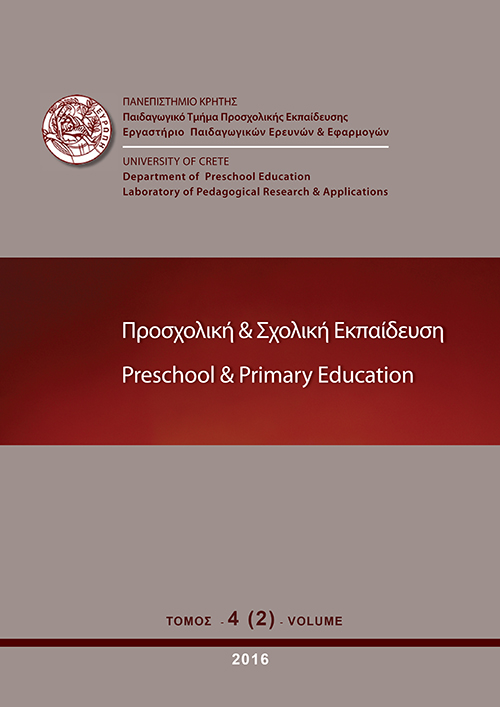Οι ρόλοι που υιοθετούν οι μαθητές/τριες όταν γίνονται μάρτυρες εκφοφισμού στο σχολείο και η σχέση τους με τις πεποιθήσεις ενσυναίσθησης και αυτεπάρκειας

Περίληψη
Introduction: Pupils who observe bullying can adopt a number of different roles: (1) assistants, who join the bullies and bully the victim, (2) reinforcers, who support the bullies by cheering, (3) outsiders, who remain uninvolved with the bullying and (4) defenders, who try to help the victim. However, relevant findings have shown that bystanders seldom act as defenders of the victims. Furthermore, research on bystander behaviour in bullying has shown that defender behaviour is related, among others, to empathy, anti-bullying attitudes, high social status and self-efficacy.
Purpose of the study: The present paper sought to examine the participant roles that primary school pupils undertake when they are bystanders (assistants, reinforces, outsiders, defenders) during school bullying events. Furthermore, it examines the degree to which empathy and self-efficacy may influence pupils’ bystander behaviours.
Method (participants, design & materials): Three hundred and sixty seven primary school pupils (172 boys and 195 girls) with mean age 10.53 years old (s.d.= 0.71) responded to the Greek version of three self-reported measures: a) the Participant Role Scale, b) the Basic Empathy Scale and c) Children’s Self-Efficacy Scale. Results: The results showed that the participant role with the highest frequency among the participating children is the one of the defender who takes the side of the victim comforting and supporting them. Furthermore, pupils’ self-efficacy and empathy were found to be moderate but significant factors in predicting the development of defending behavior among bystanders.
Implications & conclusions: The present findings have important educational and psychological implications. They suggest that defender behaviours could be enhanced by encouraging the development of pupil self-efficacy and empathy within the school context.
Λεπτομέρειες άρθρου
- Πώς να δημιουργήσετε Αναφορές
-
Lihnou, K., & Antonopoulou, E. (2016). Οι ρόλοι που υιοθετούν οι μαθητές/τριες όταν γίνονται μάρτυρες εκφοφισμού στο σχολείο και η σχέση τους με τις πεποιθήσεις ενσυναίσθησης και αυτεπάρκειας. Preschool and Primary Education, 4(2), 291–304. https://doi.org/10.12681/ppej.8663
- Τεύχος
- Τόμ. 4 Αρ. 2 (2016)
- Ενότητα
- Άρθρα

Αυτή η εργασία είναι αδειοδοτημένη υπό το CC Αναφορά Δημιουργού – Μη Εμπορική Χρήση – Παρόμοια Διανομή 4.0.
Οι συγγραφείς των άρθρων που δημοσιεύονται στο ΠΡΟΣΧΟΛΙΚΗ & ΣΧΟΛΙΚΗ ΕΚΠΑΙΔΕΥΣΗ διατηρούν τα δικαιώματα πνευματικής ιδιοκτησίας επί των άρθρων τους, δίνοντας στο περιοδικό το δικαίωμα της πρώτης δημοσίευσης. Άρθρα που δημοσιεύονται στο ΠΡΟΣΧΟΛΙΚΗ & ΣΧΟΛΙΚΗ ΕΚΠΑΙΔΕΥΣΗ διατίθενται με άδεια Creative Commons 3.0 και σύμφωνα με την άδεια μπορούν να χρησιμοποιούνται ελεύθερα, με αναφορά στο/στη συγγραφέα και στην πρώτη δημοσίευση για μη κερδοσκοπικούς σκοπούς και με δικαίωμα τροποποίησης μόνον με παρόμοια διανομή (αν αναμείξετε, τροποποιήσετε, ή δημιουργήσετε πάνω στο υλικό, πρέπει να διανείμετε τις δικές σας συνεισφορές υπό την ίδια άδεια όπως και το πρωτότυπο). To Εργαστήριο Παιδαγωγικών Ερευνών και Εφαρμογών του Παιδαγωγικού Τμήματος Προσχολικής Εκπαίδευσης του Πανεπιστημίου Κρήτης και το Εθνικό Κέντρο Τεκμηρίωσης διατηρούν το δικαίωμα να δημοσιεύουν, να αναπαραγάγουν, να παρουσιάζουν στο κοινό, να διανέμουν και χρησιμοποιούν άρθρα που δημοσιεύονται στο ΠΡΟΣΧΟΛΙΚΗ & ΣΧΟΛΙΚΗ ΕΚΠΑΙΔΕΥΣΗ σε οποιοδήποτε μέσο και μορφή είτε μεμονωμένα είτε ως μέρη συλλογικών έργων, για όλο το χρόνο διάρκειας προστασίας της πνευματικής ιδιοκτησίας και για όλες τις χώρες του κόσμου. Αυτό περιλαμβάνει ενδεικτικά και όχι αποκλειστικά, το δικαίωμα δημοσίευσης των άρθρων σε τεύχη του περιοδικού ΠΡΟΣΧΟΛΙΚΗ & ΣΧΟΛΙΚΗ ΕΚΠΑΙΔΕΥΣΗ, αναπαραγωγής και διανομής μεμονωμένων αντιγράφων των άρθρων, αναπαραγωγής ολόκληρων των άρθρων σε άλλη έκδοση του Εργαστηρίου Παιδαγωγικών Ερευνών και Εφαρμογών του Παιδαγωγικού Τμήματος Προσχολικής Εκπαίδευσης του Πανεπιστημίου Κρήτης και του Εθνικού Κέντρου Τεκμηρίωσης και αναπαραγωγής και διανομής των άρθρων ή περίληψης αυτών με χρήση πληροφορικού συστήματος αποθετηρίου.


